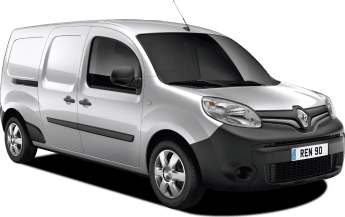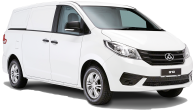The Renault Kangoo is the closest competitor to Volkswagen’s top-selling Caddy in Australia’s small van segment (under-2.5 tonne GVM). In 2020 the enduringly popular German light commercial holds a commanding 72 per cent share of this market, compared to the Kangoo’s 21 per cent.
However, such a big imbalance in sales doesn't always reflect a similar disparity in vehicle design and performance. Fact is, after spending a working week in the Kangoo, the gap between VW’s runaway sales leader and its closest competitor is not as large as those sales figures might suggest.
Renault Kangoo 2020: Compact 1.2
| Engine Type | Turbo 4, 1.2L |
|---|---|
| Fuel Type | Premium Unleaded Petrol |
| Fuel Efficiency | 4.7L/100km (combined) |
| Seating | 2 |
| Price From | $10,560 - $14,520 |
| Safety Rating |
|
Price and Features – Does it represent good value for the price? What features does it come with?
Our test vehicle is the L1 SWB (short wheelbase) Compact Van with 1.2 litre turbocharged petrol engine and six-speed EDC (Efficient Dual Clutch) automatic transmission for a list price of $26,990. Although that’s $2500 more than the six-speed manual version, it still undercuts its Caddy equivalent (TSI 220 SWB with 7-speed DSG) by $4300, which represents a substantial 14 per cent saving on purchase price alone.
The Compact is a no-frills work-focused van, as evidenced by its 15-inch steel wheels and 195/65R15 Michelin tyres (who'd have guessed) with full-size spare, hard-wearing black plastic front/rear bumpers and side body mouldings, rubberised cargo floor mat and twin-tubular steel cargo protection bars behind the driver’s seat.
.jpg)
There’s minimal standard equipment as you’d expect in such a workhorse, but it does include useful on-the-job features like rear parking sensors, height-adjustable steering column, non-radar cruise control and speed limiter, rear window demister/wiper, manual height-adjustable headlights (handy when load carrying), USB, 3.5mm auxiliary jack and 12-volt accessory plugs along with a basic multimedia system including AM/FM radio, CD player (remember those?) and Bluetooth with steering column controls.
Our test vehicle was fitted with Renault’s optional overhead cabin storage shelf and twin rear barn-doors. There are numerous other factory options like sat nav, cabin bulkhead, reversing camera etc along with Business Plus Pack and Trade Pack special option packages.
.jpg)
Design – is there anything interesting about its design?
This is a tried and tested formula that has earned the little French workhorse a loyal following, particularly in Europe. Its front wheel-drive chassis has a 2697mm wheelbase and 10.7-metre turning circle, with simple but robust MacPherson strut front suspension, rack and pinion steering, four-wheel disc brakes and a well-designed beam rear axle. This uses torsion bar primary springing supplemented by a pair of secondary coil springs for competent carrying of heavy loads.
.jpg)
The Compact lives up to its name with its 4213mm overall length and 1829mm width but the cabin is reminiscent of Doctor Who’s Tardis. The low seating height relative to the Kangoo’s 1815mm height, combined with its large glass areas, create a spacious and airy cabin environment with vast headroom you would not expect to find in such a small vehicle.

Engine and transmission – What are the key stats for the engine and transmission?
This Euro 6-compliant 1.2-litre petrol engine is a variant of that shared by numerous Renault passenger cars, but with more power and torque tapped at lower rpm that’s better suited to this load-carrying workhorse role. In other words, it’s not peaky and has good flexibility, but does require 95-98 RON premium petrol.
The direct-injection turbocharged four-cylinder produces 84kW at 4500rpm. Its 190Nm of torque peaks at 2000rpm yet remains close to full strength all the way to 4000rpm, which is admirable for such a small engine and highlights the benefits of modern variable vane turbocharger technology.
.jpg)
It also offers a manually-switched ECO economy mode and Renault’s ESM (Energy Smart Management), which allows kinetic energy produced under deceleration/braking to be recovered by the engine’s alternator and stored in the battery. Given the amount of stops and starts in a typical working van’s life, Renault claims most of this recovered energy assists in engine starting.
The six-speed EDC dual-clutch automatic transmission provides brisk acceleration from standing starts and snappy near-seamless shifting, in either auto mode or when using the sequential manual shift function.
Fuel consumption – How much fuel does it consume?
Renault’s official combined figure of 6.5L/100km looked optimistic given the dash readout was showing a 9.7 average at the end of our test, which covered just under 300km without the use of ECO mode and with more than a third of that distance under maximum GVM loading.
Our own figure, calculated from actual tripmeter and fuel bowser readings, worked out at 8.8L/100km. Therefore, based on our figures, you could expect a ‘real world’ driving range of around 630km from its 56-litre tank.
Practicality – How practical is the space inside?
The Kangoo’s 1270kg tare weight and 1810kg GVM results in a 540kg payload rating. However, we always quote kerb weights (with full fuel tank) rather than tare weights (with only 10 litres of fuel) in our reviews to keep things consistent. So if you add the missing 46 litres of petrol (or about 36kg) to the published tare weight, that drops the payload to just over 500kg which is still a very useful half a tonne.
The EDC-equipped Kangoo also has no tow rating, so if you need that capability you’ll have to opt for the six-speed manual version which is rated to tow up to 1050kg of braked trailer.
The cargo bay in our test vehicle is accessed through non-glazed sliding doors on each side (with 635mm max opening) and the optional twin barn-doors at the rear. These feature 180-degree opening to assist forklift access, asymmetric design (to minimise visual obstructions in the rear-view mirror) and a demister/wiper/washer on the left-hand door.
The cargo bay’s 1476mm internal length, with 1218mm between the rear wheel housings, means it can take either an 1165mm-square Aussie pallet or 1200 x 800mm Euro pallet. There’s also 3.0 cubic metres of total load volume available.
.jpg)
The load floor has a protective mat and three cargo-securing points each side plus two more at mid-height. The doors and lower internal panels are lined and there’s neat plastic mouldings over the wheel housings. However, there’s no cargo protection behind the passenger seat and only two tubular steel protective bars behind the driver’s, so if you’re moving lots of heavy stuff we’d recommend either the optional steel bulkhead or an aftermarket steel mesh-type cargo barrier.
Standard cabin storage options include a bottle holder and storage bin in each door, a cave-like storage cubby in the centre dash-pad and a smaller one above the glovebox. The centre console has two cup holders and a lidded storage box that doubles as an armrest. The optional overhead cabin storage shelf fitted to our test vehicle is well designed and can hold heaps of stuff.
_0.jpg)
What’s it like as a daily driver?
The engine’s zippy performance combined with the Kangoo’s agility, particularly in city delivery work, makes it an energetic daily driver. There’s a decent-sized left footrest and enough adjustment in the seat and steering column for drivers of most sizes to find a comfortable position, even though the base cushions are a tad short to provide adequate upper-thigh support over longer distances.
The ride quality when empty or lightly loaded is surprisingly supple for such a small vehicle that can carry half a tonne. Steering feel and braking response are good and there’s excellent vision through the large windscreen and front door windows, which provide clear eyelines to the door mirrors.
However, the offset join in the rear barn-doors still blocks a fair slice of the rear-view mirror’s vision and the unglazed left-side sliding door creates a big blind-spot, which can be hazardous when changing lanes and unnerving when reversing, particularly onto a busy road. The door mirrors could do with a size increase, or at least a wider-angle lens on the passenger side to assist in this area.
The gear ratios and shift protocols are well suited to the engine’s characteristics in city and suburban driving, keeping it mostly within its optimum 2000-4500rpm range where maximum torque and power seamlessly intersect.
Gearing is also tailored for economical highway travel. At 100km/h it’s bang-on maximum torque at 2000rpm which rises to 2250rpm at 110km/h. The cruise control holds its pre-set speed with discipline, although the system’s on-off switch is located low on the right-hand side of the dash where you can’t see it while driving and have to find by finger search.
Noise in the cargo bay (emanating largely from the wheel housings) at these higher speeds is around 90 on our dB meter, which can become quite enervating the longer you spend behind the wheel. So if doing lots of highway driving, we’d recommend fitting the optional steel bulkhead which is not only an effective cargo barrier but also greatly reduces cabin noise levels.
What’s it like for tradie use?
Thanks to the twin rear barn-doors we were easily able to load a 325kg weight block with the forklift, which combined with our crew of two was line-ball with the vehicle’s payload limit of just over 500kg. The rear suspension only compressed 40mm with heaps of bump-stop clearance remaining, while the nose dropped a mere 8mm.
Over a heavily patched and notoriously bumpy section of bitumen back road there was not a hint of bottoming-out and the Kangoo would not be thrown off-line or lose its composure over a variety of other roads on our test route.
.jpg)
This included our 13 per cent gradient 2.0km-long set climb at 60km/h. The dual-clutch automatic self-shifted down to third gear, where the engine settled at around 3000rpm to easily pull its maximum payload to the top. Engine braking on the way down though was almost non-existent, but not unexpected given its small cubic capacity and the load it was trying to restrain. Fortunately, the four-wheel disc brakes were more than capable of compensating for that shortfall.
As a tradie’s vehicle its applications are limited by its diminutive size, half-tonne payload capacity and lack of towing ability. However, there are plenty of other job requirements for which the Kangoo could be well suited, particularly city delivery work.
Warranty & Safety Rating
Safety – What safety equipment is fitted? What safety rating?
Its four-star ANCAP rating was achieved a decade ago (2011) and is overdue for an upgrade. There’s no AEB and a reversing camera is optional, but you can only get that with the optional rear barn-doors and R-Link sat-nav multimedia system.
At the very least, the option of glazed cargo bay side doors should be available. Even so, there’s driver and passenger front and side airbags, rear parking sensors and an active safety menu including hill-start assist, Grip Xtend (intelligent traction control) and more.
Ownership – What does it cost to own? What warranty is offered?
The Kangoo comes with a three years/unlimited km warranty. Scheduled servicing every 12 months/15,000km whichever occurs first. Capped-price servicing of $349 for the first three scheduled services.
Verdict
It’s an honest and willing little worker and, given the much lower purchase price compared to its VW Caddy Van equivalent, is worthy of consideration if you’re in the market for a small van. Just don’t expect premium safety at this end of the market. And Renault should show more confidence in Kangoo by backing it with a longer warranty than three years.
Pricing Guides


.jpg)
.jpg)




.jpg)
.jpg)
.jpg)



